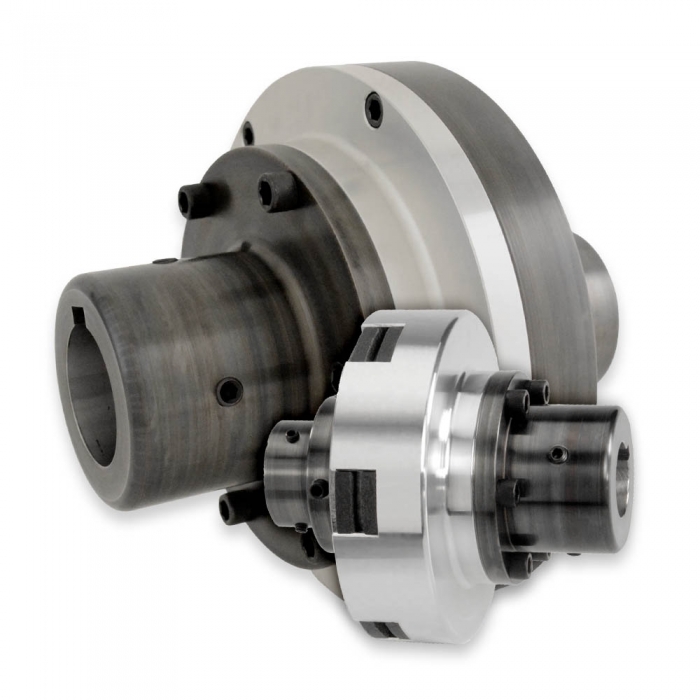Mechanical Friction Torque Limiter Mechanisms with Couplings
MECHANICAL FRICTION TORQUE LIMITERS
Mach III friction torque limiters, also known as slip clutches, are designed to transmit a fixed amount of torque from one machine component to another until an overload is experienced. A torque setting is established by compressing the adjustment nut to the desired torque output, then fixing it in place with the provided set screw(s). This can be set and adjusted in the field, or pre-set at Mach III before shipment. When the unit experiences torque in excess of the set value, the friction torque limiter slips until the overload ceases.
IMPORTANT: Mach III friction torque limiters do not disengage upon overload. A means of sensing and stopping the overload condition must be in place or a friction torque limiter will continue to slip, eventually overheating to the point where it is unfit for continued use.
MECHANICAL FRICTION TORQUE LIMITER MECHANISMS WITH COUPLINGS
Overload Protection Between Two Supported Shafts with No Angular or Parallel Misalignment
Function: Overload Protection
Drive Arrangement: Shaft to Shaft, No Angular Misalignment and/or Parallel Offset
Torque limiter mechanism is through bored and keyed to connect to a fully supported shaft.
Coupling is bored and keyed to connect to a fully supported shaft.
Operation
Continuously engaged friction torque limiter slips when the torque setting is exceeded. Continues to slip until the overload ceases.
Each half of the assembly, (1) torque limiter mechanism and (2) the coupling/sleeve assembly, is attached to a fully supported shaft.
The tabs on the outside of the friction discs in the mechanism slide into the slots in the coupling/sleeve assembly, creating a connection for the transfer of rotary motion from one shaft to the other.
IMPORTANT: If precise alignment of the two shafts cannot be obtained, consider a flexible torque coupling model.
Application
Momentary overload protection.
Torque limiters are not recommended in continuous slip or tension control applications. Consider a SensiFlex® tension control clutch or brake.
Maximum RPM varies by model. Please consult the detail sheets (below). Consult engineering if the intended application exceeds the listed maximum RPM.
Design Features
No reset is required after torque limiter slips.
The slip torque setting can be adjusted.
Both the torque limiter mechanism and coupling/sleeve assembly are bored and keyed to fit any shaft size up to the maximum shown (US & Metric).
|
Product Code |
Maximum Recommended Torque Setting |
Maximum Bore with Standard Keyway |
Detail Sheet |
|
V2G2R-STL |
200 lb-in |
0.500 in (12 mm) |
|
|
V3G2H-STL |
792 lb-in |
1.000 in (24 mm) |
|
|
V4G2H-STL |
1,406 lb-in |
1.250 in (31 mm) |
|
|
V5G2H-STL |
2,736 lb-in |
1.438 in (38 mm) |
|
|
V6G1G-STL |
3,070 lb-in |
2.000 in (52 mm) |
|
|
V6G2G-STL |
6,140 lb-in |
2.000 in (52 mm) |
|
|
V8G1K-STL |
6,066 lb-in |
2.500 in (66 mm) |
|
|
V8G2K-STL |
12,132 lb-in |
2.500 in (66 mm) |
Quote Request
If you have any questions regarding the products we are offering, pleasee fill out the form below and one of our representavies will contact your shortly. Thank you for your interest in Drive Line!

